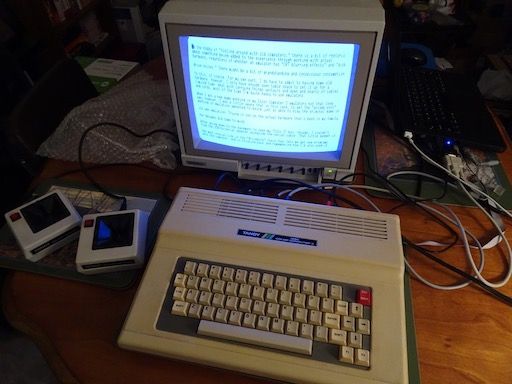A Hardware Initiative
In the hobby of “fooling around with old computers,” there is a bit of rhetoric about something being added to the experience through working with actual hardware, regardless of whether an emulator has “CRT blurring effects” and “disk drive noises.” There might be a bit of grandstanding and conspicuous consumption to this, of course. For my own part, I do have to admit to having some old hardware. However, I only have enough open table space to set it up for a limited time. What with carrying things upstairs and down and snarls of cables and cords, most of the time I’m quite happy to use emulators.
When I got a new game working in my Color Computer 3 emulators not that long ago, however, I was a little aware that in this case, to get the “arcade port” working in emulation amounted to being just as able to play the original game in its own emulation. Trying it out on the actual hardware that’s been in my family for decades did come to mind.
After going down to the basement to open my “CoCo 3” box, though, I couldn’t find the USB-to-serial adapter alongside the serial cable. That little gadget is the most crucial link in the “DriveWire” chain that lets me get new programs onto the computer, and in thinking back and remembering how I’d also used it getting new programs onto my family’s Model 100 portable I wondered if I’d placed it out of reach or just left it somewhere now long forgotten.
Then, I managed to think of another possibility, and went looking for the little pouch I could remember keeping a USB floppy drive in for working with “old disks” not quite as old as “8-bit hardware.” As I’d imagined, the USB-to-serial adapter was also in it, and then it turned out I did have the time to set up the Color Computer 3 again. Sorting out just how to use DriveWire once more took a little time, but I was able to play the game in the end, and did have to contemplate how I didn’t know the strategies that are supposed to be one key to getting high scores in it.
I had a few more go-to-games in mind, but I’d also happened on a Color Computer archive site with some “DriveWire packs,” which don’t involve quite as much going back to a newer computer to swap disk images there. Along with game amd magazine program compilations, there was an archive of “demos,” graphical and programming extravaganzas not anywhere in the same profusion as for the Commodore 64 but more than I’d known existed.
After playing around with all of that, though, I did get to thinking that while this might be the chance to make up one more post for my journal it would be something to write the first draft on the Color Computer itself. That meant sorting out a word processor I’d only did a bit of looking into of late to use as a text editor and dealing with a keyboard with the quotation mark and apostrophe over number keys and no dedicated backspace, if also the thought of “leaving everything set up a bit longer with other uses pressing for the table space.”

When I got a new game working in my Color Computer 3 emulators not that long ago, however, I was a little aware that in this case, to get the “arcade port” working in emulation amounted to being just as able to play the original game in its own emulation. Trying it out on the actual hardware that’s been in my family for decades did come to mind.
After going down to the basement to open my “CoCo 3” box, though, I couldn’t find the USB-to-serial adapter alongside the serial cable. That little gadget is the most crucial link in the “DriveWire” chain that lets me get new programs onto the computer, and in thinking back and remembering how I’d also used it getting new programs onto my family’s Model 100 portable I wondered if I’d placed it out of reach or just left it somewhere now long forgotten.
Then, I managed to think of another possibility, and went looking for the little pouch I could remember keeping a USB floppy drive in for working with “old disks” not quite as old as “8-bit hardware.” As I’d imagined, the USB-to-serial adapter was also in it, and then it turned out I did have the time to set up the Color Computer 3 again. Sorting out just how to use DriveWire once more took a little time, but I was able to play the game in the end, and did have to contemplate how I didn’t know the strategies that are supposed to be one key to getting high scores in it.
I had a few more go-to-games in mind, but I’d also happened on a Color Computer archive site with some “DriveWire packs,” which don’t involve quite as much going back to a newer computer to swap disk images there. Along with game amd magazine program compilations, there was an archive of “demos,” graphical and programming extravaganzas not anywhere in the same profusion as for the Commodore 64 but more than I’d known existed.
After playing around with all of that, though, I did get to thinking that while this might be the chance to make up one more post for my journal it would be something to write the first draft on the Color Computer itself. That meant sorting out a word processor I’d only did a bit of looking into of late to use as a text editor and dealing with a keyboard with the quotation mark and apostrophe over number keys and no dedicated backspace, if also the thought of “leaving everything set up a bit longer with other uses pressing for the table space.”
